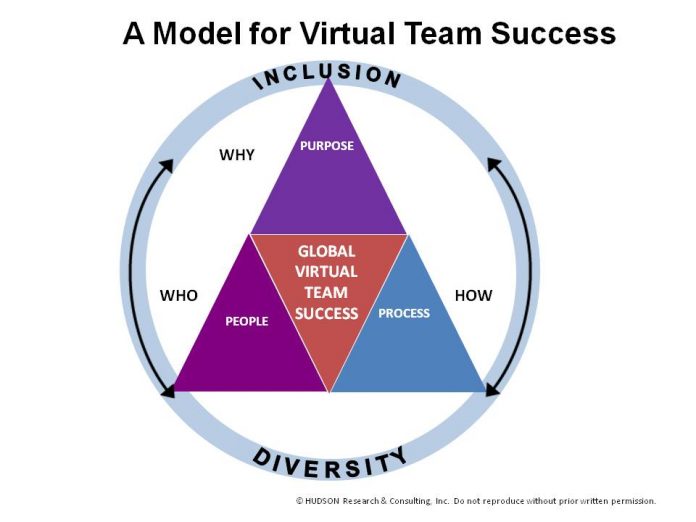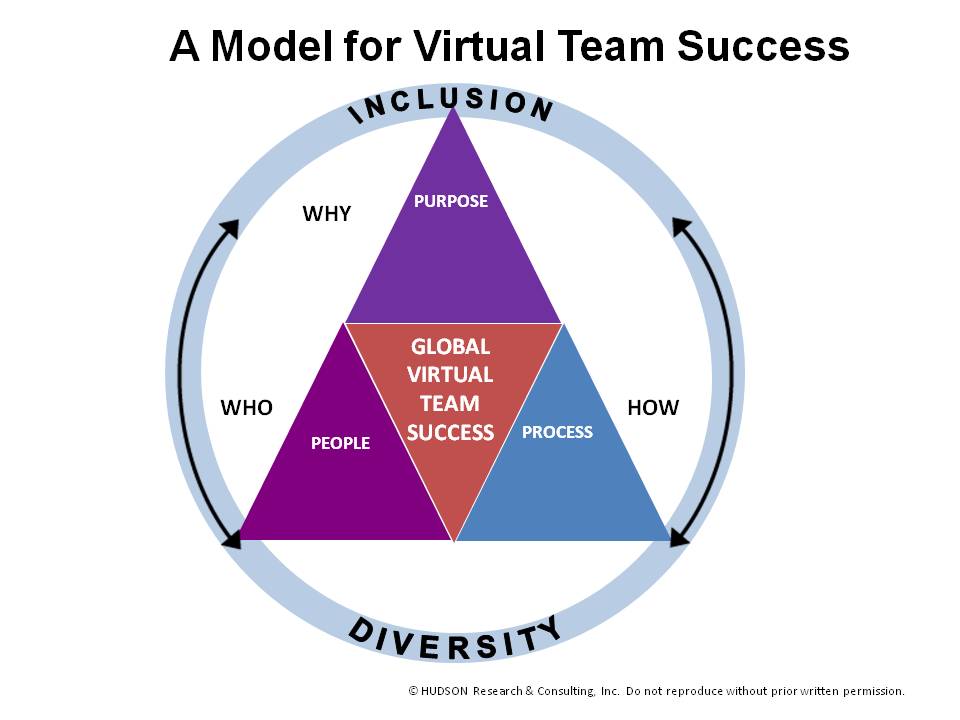
Much of today’s work is accomplished in global virtual teams, but how effectively is training preparing these teams to succeed? As an expected way of operating to accomplish results in most large organizations, global virtual teams are increasing as a result of globalization, technology, and competition for scarce talent. The stakes are high for these teams to deliver, but too often, they are not fully effective due to complexity, lack of team cohesion, competing priorities, and other factors. Training can play an important role in driving performance to a higher level.
Determining high-priority training needs— through research comparing high- vs. moderate-performing global virtual teams, and assessing what courses and curricula already exist that may be curated and repurposed—will ensure that the learning solution and modality (whether instructor-led, online, video-based, e-learning, job aids, etc.) within each unique organizational context will produce the desired results.
ANYTIME, ANYWHERE TRAINING
With technology as an enabler, Training professionals can design and deliver solutions that can be accessed anywhere, anytime, so global virtual teams are prepared with essential knowledge and skills. Small private online courses (SPOCs) discussed in the November/December 2016 issue of Training (https://trainingmag.com/trgmag-article/live-learn-and-prosper-spoc) can be leveraged to provide assessments, interactive labs, and meetups through Google hangouts.
Emphasizing on-the-job learning, as the 70:20:10 approach refers to (http://insights.ccl.org/articles/leading-effectively-articles/the-70-20-10-rule/), applies here as a rule of thumb. Design and deliver just-in-time training, job aids, discussion guides, interactive workbooks, video-based learning, and blended learning to provide “best fit” approaches to global virtual teams that can be accessed by team members or by the team as a cohort as needed to build alignment and effectiveness.
As with all training initiatives, obtaining executive sponsorship is necessary—this is particularly important for global virtual teams, because work is being conducted in a decentralized way. Without organizational support, the training will not be fully accessed or applied.
Technology also can be harnessed to create a repository for organization-wide best practices and lessons learned for effective global virtual teams, helping to foster a learning culture.
A MODEL FOR GLOBAL VIRTUAL TEAM SUCCESS
Understanding the success factors for global virtual teams is essential to guide planned training initiatives. Based on research on high-performing global teams, I created a model (see Figure 1 below) using three Ps: Purpose, People, and Process, with Diversity & Inclusion (D&I) as the overall framework. The model provides a common language for teams to discuss their strengths and challenges, and to self-diagnose problems. The examples noted are a starting place only; the needs of your organization for global virtual team development may differ and should be confirmed through needs analyses.

Because global teams are inherently diverse, differences and similarities should be acknowledged and harnessed as a source of innovation and new ideas. To be fully effective, virtual global team leaders need to be sensitive to how cultural backgrounds and biases can influence the level of participation from team members. Diverse cultural norms shape attitudes about assertiveness, hierarchy, conflict, and time—all of which may directly affect the quality of team member participation. An inclusive virtual team values and promotes the contributions of the full team, instead of relying only on individuals who are more outspoken or represent the dominant culture at headquarters.
To promote diversity and inclusion (D&I) for your global virtual teams, offer modularized learning that focuses on:
- Understanding and valuing culture differences
- Inclusive leadership
- Active listening
- Creating an environment of learning and discovery
PURPOSE: THE WHY
Global virtual teams are formed to accomplish an organizational goal (e.g., launch a new product, solve an organizational process, create a new application) to produce a desired result. The Purpose element of the model helps drive virtual team motivation, establish critical project milestones, and keep progress front and center. It also underscores the context of how the global virtual team purpose fits into larger enterprise goals.
There are two elements to Purpose:
-
Clarity around the “why”
-
Obtaining commitment and alignment
The first element lends itself to online learning, including customizable templates; the latter involves active interaction and discussion.
Here are examples of job aids and online tools that can help with Purpose:
- Template for Agile Project Charter
- Job aid for linkage between enterprise goals and the global virtual team
- Priorities worksheet for global virtual team goals (to be revisited as needed, particularly during major change)
- Discussion guide to explore priorities and purpose
- Interactive workbook to define internal and external stakeholder expectations and needs
- Template to define short- (30, 60, 90 days) and longer-term agreed-to deliverables and associated accountabilities.
PEOPLE: THE WHO
Building trust is foundational to effective performance, and must be fostered intentionally due to the lack of face-to-face contact. As reported in Harvard Business Review, lack of trust is a leading cause of virtual team dysfunction (https://hbr.org/2015/10/global-teams-that-work) due to reduced opportunities to interact in person, with cultural and language barriers compounding geographical distance.
Trust includes perceptions about intentions (team members feel they are on the same side), information (team members have confidence about timeliness, accuracy, and reliability), and interactions (free flow of communication, coupled with good judgment).
Training tools can build connections by proxy, creating a “virtual water cooler” effect.
Equal participation, which helps to create psychological safety as described by Amy Edmondson of the Harvard Business School (http://www.forbes.com/sites/worldeconomicforum/2016/04/12/is-yourteam- in-psychological-danger/2/#da857ca71dc8) promotes positive interactions and free flow of ideas while creating a more conducive environment in which innovation can flourish. In fact, The Conference Board’s recent research (https://www.conference-board.org/publications/publicationdetail.cfm?publicationid=7126) shows that organizations that are inclusive are four times more innovative than others.
As such, organizations should provide training tools that will build connections to foster active and engaged participation among all global virtual team members, such as:
- Inclusive Team Leader Guide with video examples
- Virtual profiles with photos including interests, talents, preferred communication and conflict styles, and time zone
- Communication style assessment (this can be developed as a custom tool or using the MBTI personality assessment instrument, for example)
- Communication guidelines template (including frequency, methods, expected response times, etc.)
- Rules of engagement (including participating fully, listening with respect, using team members’ time thoughtfully, e-mail etiquette, etc.)
PROCESS: THE HOW
Key elements for Process for effective virtual teams include: sponsorship; an agreed-to governance model; defined roles, responsibilities, and accountabilities; risk mitigation processes; access to shared technology; and a conflict resolution process.
Framing conflict as an expected part of team functioning promotes greater trust on the team and enhances communication that has benefits beyond the immediate issue or challenge.
Here are top training solutions to enhance team Process:
- Template to create a decision rights model: how decisions are made—which shifts according to specific sub-team workstreams
- Job aids for technology usage: when to use each type and guidelines for document sharing
- Interactive workbook to define a conflict resolution model (and guidelines about escalation when needed)
- Discussion guide for defining the governance model
- Diagnostic such as the Hudson Research & Consulting Model for Global Virtual Team Success for addressing team challenges
TRAINING AS A SOURCE OF ADVANTAGE
When addressing the learning needs of global virtual teams, it makes sense to emphasize online learning within a portfolio of blended learning solutions. Instructor-led training (ILT) is a powerful way to build inclusive behaviors and other soft skills when used strategically, but travel time and budgets often make ILT less viable.
Providing online tools to leverage Diversity & Inclusion, Purpose, People, and Process helps build high-performing global virtual teams that can accelerate innovation, growth, and engagement.
For more on this topic, listen to the Webinar recording, “Maximizing Global Team Effectiveness: The Role of Training,” on demand at: http://www.trainingmagnetwork.com/events/790?gref=tmag-tw
Marjorie Derven’s next Webinar, “Leading with Emotional Intelligence (EQ) in the New Workplace,” will be held June 6. To register, visit: http://www.trainingmagnetwork.com/events/1091
Marjorie Derven is managing partner with HUDSON Research & Consulting, Inc. (www.hudsonrc.com), which designs and delivers strategic talent management and Diversity & Inclusion solutions, often within global virtual teams. Her firm has developed research-based custom global team training solutions. Derven is a senior fellow at The Conference Board.


